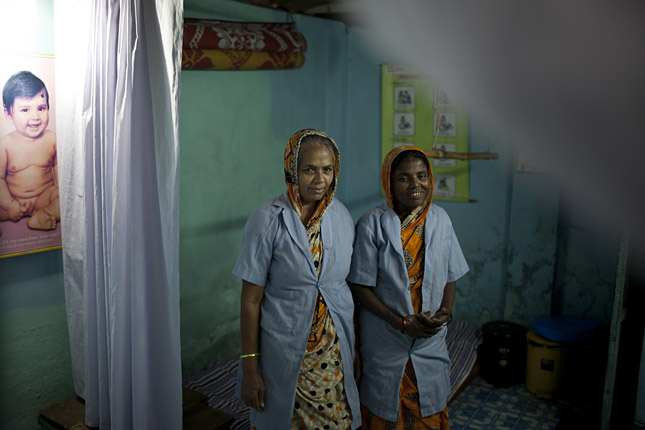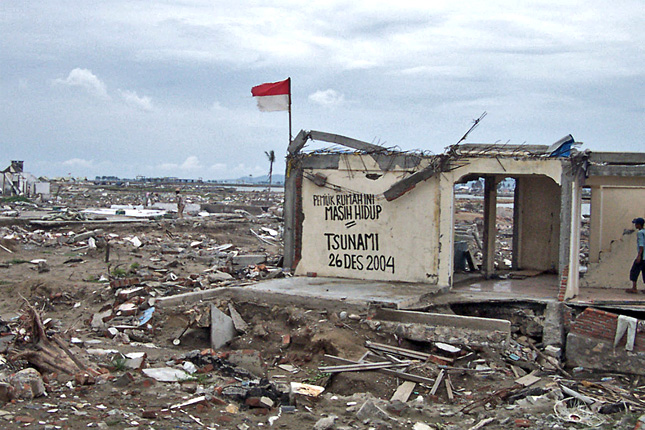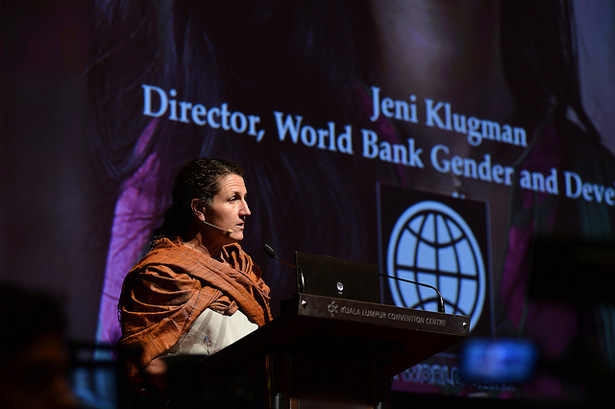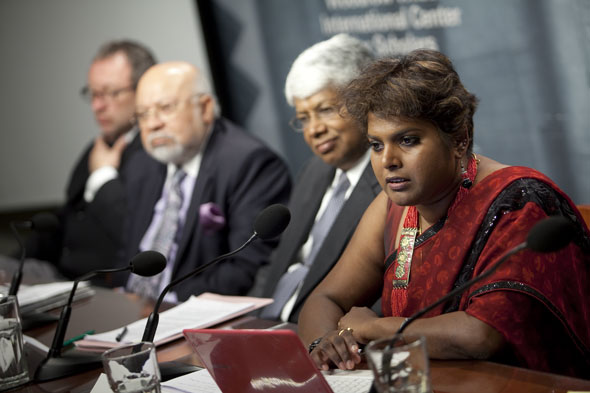-
Accounting for 1 in 3 Maternal Deaths, Health Disparities Persist in South Asia
›
The state of maternal health in South Asia is difficult to assess. Although rates of maternal mortality are declining between 2 and 2.5 percent a year overall, the region’s massive population – one fifth of the world and over 1 billion people in India alone – means it still accounts for one out of three maternal deaths. [Video Below]
-
Catalyzing Cooperation: Disaster Diplomacy and its Potential to Short-Circuit the Climate-Conflict Link
›
There is a growing chorus of voices claiming climate change will foster more conflict and violence. Books have been released on the impending age of climate wars, while media outlets dutifully report on research that purports to show how global warming will increase violence of every form, from the number of times pitchers bean batters in baseball to the rate of sexual assault.
-
Women: Producers, Not Just Reproducers
›
A major theme on day one of the global Women Deliver conference here in Kuala Lumpur was that “women are not just reproducers, they’re producers.” That is, maternal health and other gender-related issues not only affect the lives of women, girls, and children, but help shape the economies and societies that they live in.
-
The Future of South Asian Security: Prospects for a Nontraditional Regional Architecture?
›May 7, 2012 // By Kate Diamond“The nontraditional security threats of tomorrow could themselves become sources of future traditional conflict if they’re not effectively addressed today,” said Mahin Karim, the senior associate for political and security affairs at The National Bureau of Asian Research (NBR). Karim spoke during an April 11 policy briefing on nontraditional security threats in South Asia, hosted by the Wilson Center.
“The nature of nontraditional security challenges faced by South Asia may offer opportunities to change the security agenda, perhaps even subsuming traditional security concerns in the region,” she added.
Karim, along with Roy Kamphausen, Dennis Pirages, Mallika Joseph, Amal Jayawardane, Tariq Karim, and Richard Matthew, presented findings from a three-year NBR project that assessed potential threats to the region through 2025, possible policy responses, and the feasibility of implementing those responses at the national, sub-regional, and regional levels.
In looking at the potential for environmental, population, health, resource, and demographic challenges to threaten security within the region, Karim said several trends became evident across the three workshops and five reports the project produced: the growing impact of nontraditional threats on security; the potential for the region to benefit from a demographic dividend; the growing opportunities for collaboration afforded by increasing media and technological connectivity; India’s own rise as a regional and global power; and the need to examine new and alternate options for sub-regional cooperation.
A Blurring Line Between Traditional and Nontraditional Threats
The growing importance of nontraditional threats is already apparent in India, said Mallika Joseph, the executive director for the Colombo-based Regional Centre for Strategic Studies.
“Many of the challenges which we have grown up understanding as nontraditional security challenges have now migrated and are being termed as traditional security threats, and the line dividing them continues to blur,” said Joseph.
Poor governance and resource management has exacerbated economic inequalities, which are “ever-increasing, despite sustained economic growth,” said Joseph. Meanwhile, more connectivity between different regions and classes in the country has created “greater expectations, worse disappointments, and social unrest.” That unrest has been most visible in the country’s Naxalite insurgency, where years of superficial policy “address[ing] the symptom, rather than the disease itself,” means that “what was earlier a deficit of human security has morphed itself into a situation where the state now faces a security deficit.”
As India’s policymakers attempt to minimize economic inequalities, they must do so against the backdrop of a rapidly growing population. Between now and 2025, population growth in India will account for one-fifth of growth worldwide, said Joseph. While “population trends by themselves are neither inherently good or bad, they do create conditions for peace or conflict within which states must respond.”
“Demography Is a Multiplier”
The region’s changing demographics will also impact its ability to mitigate future security threats. “Demography is a multiplier,” said Joseph. “If a state has weak governance, demography can exacerbate conditions for instability.”
Sri Lanka’s recent history is a testament to this. The country’s youth “played a very important role” in the three major insurgencies that plagued the country since the 1970s, said Amal Jayawardane, an international relations professor at the University of Colombo, Sri Lanka.
Today, although the government provides free education up to the university level, youth are hampered by a disproportionately high rate of unemployment – 19 percent compared to a national average of 4.2 percent, according to the latest government labor force report. Investment in workforce opportunities for youth, along with “institutional reforms like good governance, transparency, and … eradicat[ing] corruption” will have to be considered in order to minimize the potential for youth-driven instability in the future, Jayawardane said.
Messy Boundaries, Messy Threats
“I think that one of the things that this project revealed is that we don’t have a simple definition of what constitutes South Asia per se,” said University of California, Irvine’s Richard Matthew. “It’s an interesting idea, but there’s disagreement over its actual boundaries. And it’s not clear that however we define the boundaries, they align perfectly with the threats. So the threats are messy and the boundaries of South Asia are messy.”
Many of the nontraditional threats facing the region are transnational in nature – glacial melt in the Himalayas affects water supply throughout the region, for example. Those cross-border issues merit a cross-border response.
“It isn’t like there’s a uniform response that would work for China and India and Pakistan on water security,” said Matthew. “We could and we ought to start experimenting with systems that we have reason to believe might be useful, moving them out of their national containers and into regional settings, like REDD and REDD+ and Payment for Ecosystem Services.”
Transnational Solutions for Transnational Problems
Along these lines, Mahin Karim said that the region’s youth are uniquely positioned to foster new and different ways of thinking about public policy. “The region’s youth bulge, particularly in the context of an emerging or next generation of policymakers, offers opportunities for new thinking on traditional security issues that are unhampered by the baggage of history,” she said. “Perhaps we might have a generation that’s more willing to engage multilaterally than previous or current generations have demonstrated to have been.”
Tariq Karim, Bangladesh’s high commissioner to India, said his country will depend on exactly that kind of multilateral cooperation in the coming years.
“I look at the map, I look at where Bangladesh is situated, and I can’t escape my geography,” he said. “My geography compels me to keep looking at that map and see how we can resolve our issues. On our own, it’s not possible – it’s just not possible.”
Event ResourcesSources: Sri Lanka Department of Census and Statistics.
Photo Credit: David Hawxhurst/Wilson Center. -
Minority Youth Bulges and the Future of Intrastate Conflict
›October 13, 2011 // By Richard Cincotta
From a demographic perspective, the global distribution of intrastate conflicts is not what it used to be. During the latter half of the 20th century, the states with the most youthful populations (median age of 25.0 years or less) were consistently the most at risk of being engaged in civil or ethnoreligious conflict (circumstances where either ethnic or religious factors, or both, come into play). However, this tight relationship has loosened over the past decade, with the propensity of conflict rising significantly for countries with intermediate age structures (median age 25.1 to 35.0 years) and actually dipping for those with youthful age structures (see Figure 1 below).
Showing posts from category Sri Lanka.








